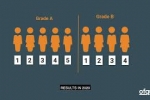1. How does it work?
As vocational and technical qualifications (VTQs) come in a range of shapes and sizes, and fulfil a range of purposes, they are not all being treated in the same way. You might know them better as Applied Generals, Tech Levels, BTECs, Cambridge Nationals, Diplomas, Technical Certificates or Technical Awards.
In all cases, exam boards and awarding organisations have made sure that the qualifications have been assessed in the most fair and consistent way and they will be recognised by educational establishments and employers. See our online qualifications explainer tool for more information.
2. Calculated results
The majority of students will receive a calculated grade for most qualifications. However, unlike GCSEs, AS and A levels, there is no overall statistical standardisation model. Awarding organisations are delivering results and carrying out quality assurance in line with Ofqual’s rules.
3. Adapted assessments
Calculated results aren’t appropriate for all qualifications, for example, because there are practical skills that need to be tested or because there isn’t enough evidence available for a calculated result to be valid and reliable. Where that’s the case, the awarding organisation may have provided adapted assessments. For example, you might have been asked to take assessments online instead of in the classroom or demonstrate a procedure on a mannequin instead of a person. This will allow you to receive a result in the normal way.
4. Delay
There are some qualifications where the only option was to delay the assessment. This might be because there was no way to carry out an adapted assessment safely or authentically.
If your assessment has been delayed, you may not get a result for that qualification this summer. Your school or college will tell you when you can next sit the assessment.
5. How results are calculated for vocational & technical qualifications
Unlike GCSE, AS and A levels, there is no overarching statistical standardisation model, but Ofqual requires that all AOs follow the same broad process to calculate grades. Awarding organisations are delivering the results and carrying out quality assurance in line with Ofqual’s Extraordinary regulatory framework for VTQ, which has been designed to allow the awarding organisations flexibility to determine the most suitable approach for their qualifications.
Different approaches will be taken depending on the evidence available, and the nature and structure of a qualification.
This means that the way your result has been calculated for one qualification, may be different to the way it has been calculated for another. Whatever the exact approach that is taken to issuing a calculated result, awarding organisations need to:
- gather evidence such as previously banked assessment results, centre assessment grades, school or college results from recent years
- quality-assure the evidence that is to be relied upon
- ensure that the outcomes are not out of line with expectations
Ofqual has worked with awarding organisations to support them through the process of applying this to their qualifications.
6. The stages
-
Evidence: centre assessment grade, awarding organisation calculated grade or both.
-
Quality assurance by the awarding organisation.
-
Overall check on outcomes to ensure they are not out of line with expectations.
Minimum evidential threshold: there must be at least one trusted source of evidence and a sufficiently robust method of quality assurance.

